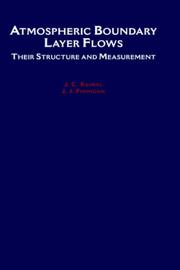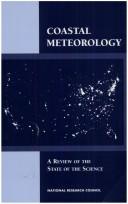| Listing 1 - 10 of 19 | << page >> |
Sort by
|
Book
ISBN: 0870718452 0870718444 9780870718458 9780870718441 Year: 2016 Publisher: Corvallis
Abstract | Keywords | Export | Availability | Bookmark
 Loading...
Loading...Choose an application
- Reference Manager
- EndNote
- RefWorks (Direct export to RefWorks)
Book
ISBN: 3031326687 3031326679 Year: 2023 Publisher: Cham, Switzerland : Springer,
Abstract | Keywords | Export | Availability | Bookmark
 Loading...
Loading...Choose an application
- Reference Manager
- EndNote
- RefWorks (Direct export to RefWorks)
This book is filled with didactic elements such as exercises, charts and case study examples. It introduces a set of fundamental equations that govern the conservation of mass (dry air, water vapor, trace gases), momentum and energy in the lower atmosphere. It offers students an up-to-date literature overview and introduces theory to a field that is mostly empirical in nature. Dedicated to undergraduate or graduate students in atmospheric sciences and meteorology, this textbook compels students about the importance of the subject and its application. Simplifications of each of the equations are made in the context of boundary-layer processes. Extended from these equations the author then discusses a set of issues fundamental to boundary layer meteorology, including (1) turbulence generation and destruction, (2) force balance in various portions of the lower atmosphere, (3) canopy flow, (4) tracer diffusion and footprint theory, (5) principles of flux measurement and interpretation, (6) models for land evaporation, (7) models for surface temperature response to land use change, and (8) boundary layer budget calculations for heat, water vapor and carbon dioxide. This second edition is enhanced with new materials on the marine boundary layer and on three contemporary topics: the urban boundary layer, the polluted boundary layer and the cloudy boundary layer in a changing climate. Problem sets are supplied at the end of each chapter to reinforce the concepts and theory presented in the main text. This volume offers the accumulation of insights gained by the author during his academic career as a researcher and teacher in the field of boundary-layer meteorology.
Atmospheric science. --- Atmospheric Science. --- Atmospheric sciences --- Earth sciences --- Atmosphere --- Boundary layer (Meteorology)
Book
ISBN: 0128181605 0128181613 9780128181614 9780128181607 Year: 2021 Publisher: London, United Kingdom : Academic Press, an imprint of Elsevier,
Abstract | Keywords | Export | Availability | Bookmark
 Loading...
Loading...Choose an application
- Reference Manager
- EndNote
- RefWorks (Direct export to RefWorks)
Magnetosphere. --- Magnetospheric boundary layer. --- Planets --- Magnetospheres. --- Planetary magnetospheres --- Magnetosphere --- Boundary layer (Meteorology) --- Upper atmosphere --- Atmospheres --- Earth (Planet) --- Earth
Book
ISBN: 9780128170939 9780128170922 012817093X 0128170921 Year: 2023 Publisher: London, United Kingdom : Academic Press is an imprint of Elsevier,
Abstract | Keywords | Export | Availability | Bookmark
 Loading...
Loading...Choose an application
- Reference Manager
- EndNote
- RefWorks (Direct export to RefWorks)
Conceptual Boundary Layer Meteorology: The Air Near Here explains essential boundary layer concepts in a way that is accessible to a wide number of people studying and working in the environmental sciences. It begins with chapters designed to present the language of the boundary layer and the key concepts of mass, momentum exchanges, and the role of turbulence. The book then moves to focusing on specific environments, uses, and problems facing science with respect to the boundary layer.
Book
ISBN: 1283246384 9786613246387 0080931650 0444528644 9780444528643 Year: 2010 Publisher: Amsterdam London Elsevier Science
Abstract | Keywords | Export | Availability | Bookmark
 Loading...
Loading...Choose an application
- Reference Manager
- EndNote
- RefWorks (Direct export to RefWorks)
The author argues that, after five decades of debate about the interactive of solar wind with the magnetosphere, it is time to get back to basics. Starting with Newton's law, this book also examines Maxwell's equations and subsidiary equations such as continuity, constitutive relations and the Lorentz transformation; Helmholtz' theorem, and Poynting's theorem, among other methods for understanding this interaction. Includes chapters on prompt particle acceleration to high energies, plasma transfer event, and the low latitude boundary layer More than 200 figures i
Artificial satellites in remote sensing. --- IMAGE (Artificial satellite). --- Magnetosphere -- Congresses. --- Magnetosphere. --- Magnetosphere --- Magnetospheric boundary layer --- Planets --- Medicine --- Health & Biological Sciences --- Gastroenterology --- Magnetospheres --- Magnetospheric boundary layer. --- Magnetospheres. --- Earth. --- Earth (Planet) --- Planetary magnetospheres --- Boundary layer (Meteorology) --- Upper atmosphere --- Atmospheres --- Earth

ISBN: 0197560164 1280524545 9786610524549 0195362772 142940003X 9781429400039 9780195362770 0195062396 9780195062397 9781280524547 6610524548 9780197560167 Year: 1994 Publisher: New York Oxford University Press
Abstract | Keywords | Export | Availability | Bookmark
 Loading...
Loading...Choose an application
- Reference Manager
- EndNote
- RefWorks (Direct export to RefWorks)
Boundary layer meteorology is the study of the physical processes that take place in the layer of air that is most influenced by the earth's underlying surface. This text/reference gives an uncomplicated view of the structure of the boundary layer, the instruments available for measuring its mean and turbulent properties, how best to make the measurements, and ways to process and analyze the data. The main applications of the book are in atmospheric modelling, wind engineering, air pollution, and agricultural meteorology. The authors have pioneered research on atmospheric turbulence and flow, and are noted for their contributions to the study of the boundary layer. This important work will interest atmospheric scientists, meteorologists, and students and faculty in these fields.
Boundary layer (Meteorology) --- Atmosphere, Lower --- Atmospheric boundary layer --- Friction layer (Meteorology) --- Ground layer (Meteorology) --- Lower atmosphere --- Planetary boundary layer --- Surface boundary layer --- Surface layer (Meteorology) --- Atmosphere --- Atmosphere. --- Atmospheric science
Periodical
Abstract | Keywords | Export | Availability | Bookmark
 Loading...
Loading...Choose an application
- Reference Manager
- EndNote
- RefWorks (Direct export to RefWorks)
Geology. Earth sciences --- Boundary layer (Meteorology) --- Couche limite (Météorologie) --- Periodicals. --- Périodiques --- Couche limite (Météorologie) --- Chemistry --- Environmental Chemistry --- Meteorology --- Earth Sciences --- Physics --- General and Others --- Chemistry. --- Meteorology. --- Earth Sciences. --- Atmosphere, Lower --- Atmospheric boundary layer --- Friction layer (Meteorology) --- Ground layer (Meteorology) --- Lower atmosphere --- Planetary boundary layer --- Surface boundary layer --- Surface layer (Meteorology) --- Atmosphere
Book
ISBN: 3319608533 3319608517 Year: 2018 Publisher: Cham : Springer International Publishing : Imprint: Springer,
Abstract | Keywords | Export | Availability | Bookmark
 Loading...
Loading...Choose an application
- Reference Manager
- EndNote
- RefWorks (Direct export to RefWorks)
This textbook introduces a set of fundamental equations that govern the conservation of mass (dry air, water vapor, trace gas), momentum and energy in the lower atmosphere. Simplifications of each of these equations are made in the context of boundary-layer processes. Extended from these equations the author then discusses a key set of issues, including (1) turbulence generation and destruction, (2) force balances in various portions of the lower atmosphere, (3) canopy flow, (4) tracer diffusion and footprint theory, (5) principles of flux measurement and interpretation, (6) models for land evaporation, (7) models for surface temperature response to land use change, and (8) boundary layer budget calculations for heat, water vapor and carbon dioxide. Problem sets are supplied at the end of each chapter to reinforce the concepts and theory presented in the main text. This volume offers the accumulation of insights gained by the author during his academic career as a researcher and teacher in the field of boundary-layer meteorology.
Earth sciences. --- Climatology. --- Meteorology. --- Atmospheric sciences. --- Ecology. --- Earth Sciences. --- Atmospheric Sciences. --- Terrestial Ecology. --- Balance of nature --- Biology --- Bionomics --- Ecological processes --- Ecological science --- Ecological sciences --- Environment --- Environmental biology --- Oecology --- Environmental sciences --- Population biology --- Aerophysics --- Meteorology, Physical --- Physical meteorology --- Atmospheric science --- Aerology --- Climate --- Climate science --- Climate sciences --- Science of climate --- Geosciences --- Physical sciences --- Ecology --- Ecology . --- Atmospheric sciences --- Earth sciences --- Atmosphere --- Boundary layer (Meteorology)

ISBN: 0309046874 9786610203093 0585085137 1280203099 030957272X 0585143048 9780585143040 9780309046879 Year: 1992 Publisher: Washington, D.C. : National Academy Press,
Abstract | Keywords | Export | Availability | Bookmark
 Loading...
Loading...Choose an application
- Reference Manager
- EndNote
- RefWorks (Direct export to RefWorks)
Coasts. --- Coastal landforms --- Coastal zones --- Coastlines --- Maritime meteorology --- Meteorology, Maritime --- Marine meteorology. --- Boundary layer (Meteorology) --- Atmosphere, Lower --- Atmospheric boundary layer --- Friction layer (Meteorology) --- Ground layer (Meteorology) --- Lower atmosphere --- Planetary boundary layer --- Surface boundary layer --- Surface layer (Meteorology) --- Atmosphere --- Landforms --- Seashore --- Meteorology --- Oceanography
Book
ISBN: 9780691143545 0691143544 9786612936173 1400834716 1282936174 9781400834716 Year: 2010 Publisher: Princeton, NJ
Abstract | Keywords | Export | Availability | Bookmark
 Loading...
Loading...Choose an application
- Reference Manager
- EndNote
- RefWorks (Direct export to RefWorks)
Wally Broecker is one of the world's leading authorities on abrupt global climate change. More than two decades ago, he discovered the link between ocean circulation and climate change, in particular how shutdowns of the Great Ocean Conveyor--the vast network of currents that circulate water, heat, and nutrients around the globe--triggered past ice ages. Today, he is among the researchers exploring how our planet's climate system can abruptly "flip-flop" from one state to another, and who are weighing the implications for the future. In The Great Ocean Conveyor, Broecker introduces readers to the science of abrupt climate change while providing a vivid, firsthand account of the field's history and development. Could global warming cause the conveyor to shut down again, prompting another flip-flop in climate? What were the repercussions of past climate shifts? How do we know such shifts occurred? Broecker shows how Earth scientists study ancient ice cores and marine sediments to probe Earth's distant past, and how they blend scientific detective work with the latest technological advances to try to predict the future. He traces how the science has evolved over the years, from the blind alleys and wrong turns to the controversies and breathtaking discoveries. Broecker describes the men and women behind the science, and reveals how his own thinking about abrupt climate change has itself flip-flopped as new evidence has emerged. Rich with personal stories and insights, The Great Ocean Conveyor opens a tantalizing window onto how Earth science is practiced.
Ocean-atmosphere interaction --- Atmospheric circulation --- Ocean circulation --- Climatic changes --- Boundary layer (Meteorology) --- Interaction mer-atmosphère --- Circulation atmosphérique --- Climat --- Couche limite (Météorologie) --- Changements --- Atmospheric circulation. --- Climatic changes. --- Ocean circulation. --- Ocean-atmosphere interaction. --- Boundary layer (Meteorology). --- Interaction mer-atmosphère --- Circulation atmosphérique --- Couche limite (Météorologie) --- Air-sea interaction --- Air-sea interactions --- Atmosphere-ocean interaction --- Atmosphere-ocean interactions --- Atmospheric-oceanic interactions --- Interaction of atmosphere and ocean --- Interactions of atmosphere and ocean --- Ocean-meteorological relations --- Oceanic-atmospheric interactions --- Sea-air interaction --- Sea-air interactions --- Marine meteorology --- Oceanography --- Teleconnections (Climatology) --- Atmospheric motion --- Wind circulation --- Climatology --- Meteorology --- Grosswetterlagen --- Stratospheric circulation --- Winds --- Circulation, Ocean --- Changes, Climatic --- Changes in climate --- Climate change --- Climate change science --- Climate changes --- Climate variations --- Climatic change --- Climatic fluctuations --- Climatic variations --- Global climate changes --- Global climatic changes --- Climate change mitigation --- Atmosphere, Lower --- Atmospheric boundary layer --- Friction layer (Meteorology) --- Ground layer (Meteorology) --- Lower atmosphere --- Planetary boundary layer --- Surface boundary layer --- Surface layer (Meteorology) --- Atmosphere --- Environmental aspects --- Physical oceanography --- Global environmental change
| Listing 1 - 10 of 19 | << page >> |
Sort by
|

 Search
Search Feedback
Feedback About UniCat
About UniCat  Help
Help News
News